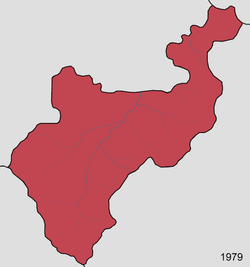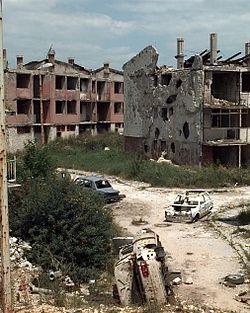User:Luziyca/Sandbox3: Difference between revisions
No edit summary |
No edit summary |
||
| Line 1: | Line 1: | ||
{{Region icon Kylaris}} | {{Region icon Kylaris}} | ||
{{Infobox military conflict | {{Infobox military conflict | ||
| conflict = Lemovician | | conflict = Lemovician War | ||
| width = | | width = | ||
| partof = | | partof = | ||
| image = [[File:LemovWarMap.gif|250px]] | | image = [[File:LemovWarMap.gif|250px]] | ||
| caption = Animated map of the Lemovician | | caption = Animated map of the Lemovician War<br>{{colorbox|#007846}} [[Lemovicia|Lemovician government]]<br>{{colorbox|#C24650}} [[Miersan Entity|Miersan separatists]] (until 1985)/[[Liberal Democratic Party of Lemovicia|Opposition]]-separatist coalition (from 1985)<br>{{colorbox|#6699CC}} [[Liberal Democratic Party of Lemovicia|Opposition]] forces (until 1985) | ||
| date = 21<sup>st</sup> November, 1979 - 22<sup>nd</sup> June, 1992<br>({{Age in years, months, weeks and days|month1=3|day1=5|year1=1979|month2=11|day2=21|year2=1992}}) | | date = 21<sup>st</sup> November, 1979 - 22<sup>nd</sup> June, 1992<br>({{Age in years, months, weeks and days|month1=3|day1=5|year1=1979|month2=11|day2=21|year2=1992}}) | ||
| place = {{flag|Lemovicia}}<br>{{flag|West Miersa}} | | place = {{flag|Lemovicia}}<br>{{flag|West Miersa}} | ||
| Line 38: | Line 38: | ||
==Origins== | ==Origins== | ||
The roots of the | The roots of the Lemovician War are believed to begin with the {{wp|industrialisation}} of present-day [[Lemovicia]]: due to the substantial {{wp|coal}} and {{wp|iron}} deposits present in the region, migrants, primarily from the [[Miersan Governorate]] of the [[Narozalic Empire]], which at the time, ruled over both present-day [[West Miersa]] and Lemovicia. This allowed substantial migration of {{wp|Polish people|Miersans}} to Lemovicia, ultimately forming a substantial majority in the northern regions of [[Malomiersa]] by 1900. | ||
Following the implementation of the [[Godfredson Plan]] in 1936 which granted [[Miersa]] independence as [[West Miersa]] and [[East Miersa]], Lemovicia was placed under the control of the [[West Miersa|Miersan Federation]], due to Lemovicia's long association with the [[Soravia|Soravian]] [[Miersan Governate]]. Under West Miersan rule, the region underwent a policy of {{wp|Polonization|Miersanization}}, which had the effect of reducing the number of ethnic Lemovicians from 46% in 1936 to 34% in 1977. | Following the implementation of the [[Godfredson Plan]] in 1936 which granted [[Miersa]] independence as [[West Miersa]] and [[East Miersa]], Lemovicia was placed under the control of the [[West Miersa|Miersan Federation]], due to Lemovicia's long association with the [[Soravia|Soravian]] [[Miersan Governate]]. Under West Miersan rule, the region underwent a policy of {{wp|Polonization|Miersanization}}, which had the effect of reducing the number of ethnic Lemovicians from 46% in 1936 to 34% in 1977. | ||
| Line 65: | Line 65: | ||
===West Miersan attacks=== | ===West Miersan attacks=== | ||
[[File:Novi_travnik_u_ratu.jpg|250px|thumb|left|[[ | [[File:Novi_travnik_u_ratu.jpg|250px|thumb|left|[[Mostar, West Miersa|Mostar]] after the [[Battle of Mostar]], 1983]] | ||
Following the end of the [[Miersan War]] in 1982, while the [[West Miersa|West Miersan]] [[Miersan National Army]] was battered by the war, it was now able to focus on fighting the Lemovician separatists. | Following the end of the [[Miersan War]] in 1982, while the [[West Miersa|West Miersan]] [[Miersan National Army]] was battered by the war, it was now able to focus on fighting the Lemovician separatists, which due to their small size compared to the West Miersan military, combined with the size of the Episemialist militias, was seen as easy to defeat. | ||
Thus, on 7 January, 1983, the Episemialist militias and the West Miersan military launched an offensive against the northwestern regions of [[Malomiersa]], with the intention of securing West Miersan control over the powiat of [[Czarnoziem, Małomiersa|Czarnoziem]]. This surprise offensive was a success, particularly as many {{wp|Polish people|Miersans}}, who chafed under Lemovician rule, rebelled against the Lemovician separatists, and by the end of January, Czarnoziem had fallen to West Miersan forces. However, the [[Revolutionary Defence Forces (Lemovicia)|Revolutionary Defence Forces]] were able to secure the perimeter around the northwestern front line, which held the Miersans back. | |||
As supplies from [[East Miersa]] became less reliable, it became urgent that a supply line be restored: thus, while [[Nikolas Lezana]] sought to have a "quick offensive to the nrothwest" to repel the West Miersans, [[Ociote Sasiambarena]] insisted on an attack to take the [[Środkowa corridor]] in order to have a supply line from [[Checkpoint Gamma]] to the rest of Lemovician-controlled territory. | |||
Thus, in May 1983, the Lemovician separatists abandoned the northwest in favour of an offense to take control of the Środkowa corridor. While by July, the Środkowa corridor was secured, including the town of [[Heŕibeŕija|Białewłosy]], in [[Mostar, West Miersa|Mostar]], Lemovician defenders began fighting a vicious battle, lasting until October, when the city of Mostar fell to the West Miersans. | |||
(TBC) | (TBC) | ||
Revision as of 06:36, 21 December 2020
| Lemovician War | |||||||
|---|---|---|---|---|---|---|---|
 Animated map of the Lemovician War Lemovician government Miersan separatists (until 1985)/Opposition-separatist coalition (from 1985) Opposition forces (until 1985) | |||||||
| |||||||
| Belligerents | |||||||
|
Supported by: TBD |
TBD | ||||||
| Commanders and leaders | |||||||
|
|
File:LemovEntFlag.png Otxote Sasiambarrena File:LemovEntFlag.png Gizon Artalolea File:LemovEntFlag.png Xuban Urtizverea † File:LemovEntFlag.png Seniko Urdiaga | ||||||
| Strength | |||||||
|
|
| ||||||
| Casualties and losses | |||||||
|
Lemovician 30,521 killed 38,696 wounded 14,696 missing and captured |
West Miersan 15,359 killed 41,506 wounded 18,921 missing and captured | ||||||
|
c. 300,000 civilians killed 2,171,631 internally displaced persons and refugees | |||||||
The Lemovician War (Lemovician: Mendiluŕeko bijna, Miersan: Małomierska wojna), often known as the Little War (Lemovician: Bijna cikija, Miersan: Mała wojna) was a twelve-year long war of independence in Malomiersa and West Miersa, which lasted from 1979 until 1992.
(TBC)
Origins
The roots of the Lemovician War are believed to begin with the industrialisation of present-day Lemovicia: due to the substantial coal and iron deposits present in the region, migrants, primarily from the Miersan Governorate of the Narozalic Empire, which at the time, ruled over both present-day West Miersa and Lemovicia. This allowed substantial migration of Miersans to Lemovicia, ultimately forming a substantial majority in the northern regions of Malomiersa by 1900.
Following the implementation of the Godfredson Plan in 1936 which granted Miersa independence as West Miersa and East Miersa, Lemovicia was placed under the control of the Miersan Federation, due to Lemovicia's long association with the Soravian Miersan Governate. Under West Miersan rule, the region underwent a policy of Miersanization, which had the effect of reducing the number of ethnic Lemovicians from 46% in 1936 to 34% in 1977.
In the 1970s, as coal and iron mines closed down in Malomiersa, tensions grew between Lemovicians and Miersans, as they competed for fewer and fewer jobs. This led to Lemovicians reasserting their identity against the Miersan majority, with two major organizations, Eztebe Tolaregain's Lemovician Cultural Alliance, and Nikola Lezana's Lemovician Section of the Workers' International become the two main Lemovician organizations. While the former primarily focused on a cultural revival, the latter sought a political solution to the plight of the Lemovician nation.
Prelude
From 1977 onward, terrorist attacks became a common feature of life in the region, with the first major one taking place in September of that year, when a bomb planted at a West Miersan government office in Sechia injured two people. While this was a lone wolf attack, in l978, the Aranoak was founded, with the express purpose of launching a campaign of terrorism to "cripple northern rule [over Lemovicia]."
Between October 1978 and November 1979, Aranoak committed six terrorist attacks, killing 19 people and injuring 55 people. In response, the West Miersan government engaged in extensive crackdowns against Lemovicians, which led to growing opposition to West Miersan rule.
However, shortly after East Miersa invaded West Miersa, thus starting the Miersan War, the Lemovician Section of the Workers' International, led by Ociote Sasiambarena and Nikolas Lezana took it upon themselves to seize control of government buildings in Mistózburó (present-day Topagunea) and proclaimed their independence from West Miersa on 21 November, 1979.
Events
Early phases

Upon their proclamation of independence from West Miersa, the nascent Lemovician state became aligned with East Miersa, with the Lemovician Section of the Workers' International establishing a paramilitary force that would form the nucleus of the modern-day Revolutionary Defence Forces.
This proclamation of independence from West Miersa meant that the Lemovician separatists were able to cooperate with the invading East Miersans, but also reduce the likelihood that the region would be a centre of partisan activity against the East Miersan People's Protection Forces. While initially, the Lemovician separatists only had control over Lemovician-majority areas of Malomiersa, their quick advance, aided by the East Miersan forces, by the end of the year, the Lemovician separatists were able to seize control of the entirety of the voivodeship of Malomiersa.
At this time, Miersan militias began to rise, particularly in the northern regions of the Malomiersan voivodeship, which had a significant Miersan population, which proved to be a problem to the People's Protection Forces. Despite these challenges, the Lemovician separatists were able to institute a constitution at the Second Party Congress in 1980, which established Lemovicia as a socialist state, basing themselves off of the Kirenian and East Miersan models, although they took some influences from the Amathian Equalist Republic and the Socialist Republic of Slirnia.
Throughout 1980 and into 1981, resistance against Lemovician separatist control over Malomiersa was largely done by local Episemialist militias in the northern regions, which with the help of East Miersan forces, were able to be repulsed. However, in July 1981, the first battle of Sechia took place, which saw the Miersan-majority neighbourhoods of the city be freed by local militias, and return to West Miersan rule.
Despite this setback, the Lemovician Section of the Workers' International was able to maintain control over most of the voivodeship of Malomiersa well into 1982. However, with the signing of the Treaty of San Alessandro in 1982, which ended the Miersan War between West Miersa and East Miersa, East Miersan forces withdrew from Lemovicia, leading to the Revolutionary Defence Forces largely fighting on their own.
West Miersan attacks
Following the end of the Miersan War in 1982, while the West Miersan Miersan National Army was battered by the war, it was now able to focus on fighting the Lemovician separatists, which due to their small size compared to the West Miersan military, combined with the size of the Episemialist militias, was seen as easy to defeat.
Thus, on 7 January, 1983, the Episemialist militias and the West Miersan military launched an offensive against the northwestern regions of Malomiersa, with the intention of securing West Miersan control over the powiat of Czarnoziem. This surprise offensive was a success, particularly as many Miersans, who chafed under Lemovician rule, rebelled against the Lemovician separatists, and by the end of January, Czarnoziem had fallen to West Miersan forces. However, the Revolutionary Defence Forces were able to secure the perimeter around the northwestern front line, which held the Miersans back.
As supplies from East Miersa became less reliable, it became urgent that a supply line be restored: thus, while Nikolas Lezana sought to have a "quick offensive to the nrothwest" to repel the West Miersans, Ociote Sasiambarena insisted on an attack to take the Środkowa corridor in order to have a supply line from Checkpoint Gamma to the rest of Lemovician-controlled territory.
Thus, in May 1983, the Lemovician separatists abandoned the northwest in favour of an offense to take control of the Środkowa corridor. While by July, the Środkowa corridor was secured, including the town of Białewłosy, in Mostar, Lemovician defenders began fighting a vicious battle, lasting until October, when the city of Mostar fell to the West Miersans.
(TBC)
Stalemate and renewed offensive
Operation Storm and Operation Michael

Final phases

Negotiations
Aftermath


